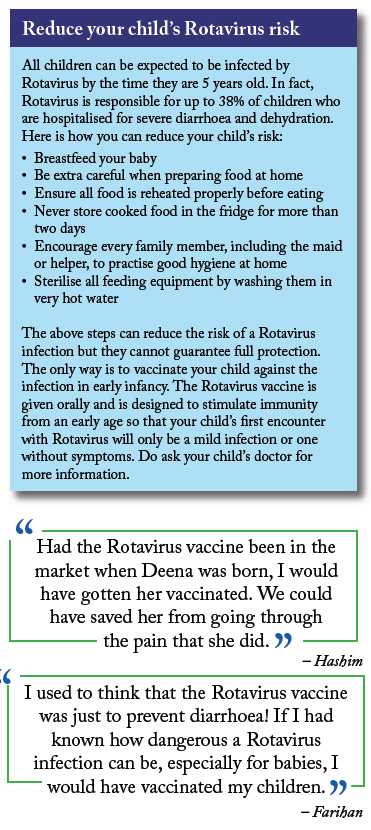Hashim and his wife Ariza were at the end of their rope. Their youngest child, three-year-old Deena Sofya, was suffering from a high fever and violent bouts of vomiting and diarrhoea. Several days had passed and despite numerous trips to the clinic, Deena’s temperature had not gone down. She was constantly tired and drowsy. She could not eat and would throw up anything Hashim tried to give her. She would not even drink milk. Not a single ounce of energy was left in her weak little body and her parents were getting desperate.
“We tried everything to bring down Deena’s fever,” said Hashim. “We sponged her body and even tried feeding her icecream! Nothing worked, so we quickly took her to the hospital.”
Meanwhile, not too far away, Farihan and her husband Anizam were worried that something was wrong with their son, one year-old Amzar. Ever since Farihan brought him home from the nursery on Friday, he had been cranky. He started vomiting the next day. On Sunday, Farihan brought Amzar to the GP clinic where he was diagnosed with stomach wind and was prescribed some wind and anti-vomit medications.
Monday lolled around and because Amzar’s condition seemed to have improved, he was sent back to the nursery while Farihan returned to her full-time job as a university lecturer. But when Farihan picked up her elder daughter, six-year-old Fawza, from preschool that day, she found Fawza with the same symptoms as Amzar: a stomach ache and by night time, severe vomiting.
“The first cause that sprang to mind was food poisoning. I had read about Rotavirus but I never made the connection!” said Farihan. “The next day, Amzar started to have a fever and began vomiting again! We knew we had to bring the children to the hospital.”
THE DIAGNOSIS
Just like Deena, Amzar and Fawza were diagnosed with Rotavirus infection. Finally, the parents knew that this was no ordinary case of diarrhoea and vomiting. The next question was, “What is Rotavirus?”
Rotavirus is a highly contagious virus that infects the bowels. It is usually found in the faeces of infected children and is transmitted via contact with infected faeces.
Rotavirus can easily spread in numerous ways: when children do not wash their hands after using the toilet or before eating, or from adults who have the infection or are handling infants who are infected. Because Rotavirus can survive for hours on the human hand and days on hard and dry surfaces, it can also spread via contaminated water, food or when a child touches contaminated objects and surfaces, and then touches her mouth.
Identifying a Rotavirus infection
Rotavirus infection causes fever, nausea and vomiting, followed by abdominal cramps and frequent, watery diarrhoea for 3 to 8 days. The diarrhoea can become so severe that rapid dehydration can occur. Signs of dehydration include thirst, irritability, lethargy, sunken eyes, a dry mouth and tongue, dry skin and in infants, a dry diaper for several hours.
AT THE HOSPITAL
For five days, Deena lay in the hospital. She was put on an intravenous drip to replace all the fluids she had lost from vomiting and diarrhoea. To her anxious parents’ relief, her condition gradually improved. Had Deena been younger, the dehydration she had experienced may have been fatal. For children between 6 and 24 months, severe dehydration can result in shock, kidney failure, brain damage and even death.
As for one-year-old Amzar, the threat of dehydration was very real. “Being older, Fawza recovered from the Rotavirus infection more easily. With Amzar, I noticed his skin getting saggy. He was also very weak. But once he was put on the drip, he improved rapidly. Five days later, he is eating porridge again!” said Farihan with a smile.







Comments